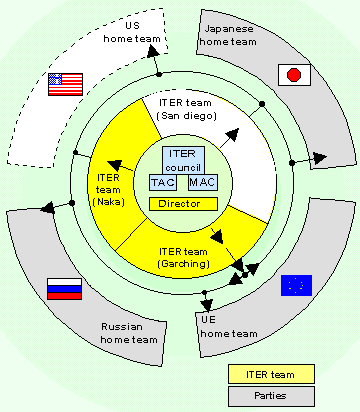|
The ITER project 
1- Objectives
Research on controlled fusion and
its contributory fields, has made great strides over the last few years both in Europe and in the world, whether in physics, materials, technology or in the
concept of a future current generating fusion reactor. This progress is the
result of work on many "specialised" experimental installations.The , JET
tokamak  , for example, is dedicated to the physics of
high performance plasmas over short periods (a few seconds). The Tore Supra machine is more specialised on
lower performance plasmas that last much longer (2 minutes or more). Due to the remarkable results obtained
over the last few years, the research community involved in these studies on controlled magnetic fusion is ready to take
a further step: demonstrate the sustained combustion of a deuterium-tritium plasma over long periods. This is the main goal of ITER (International Thermonuclear Experimental Reactor), the next
generation machine. , for example, is dedicated to the physics of
high performance plasmas over short periods (a few seconds). The Tore Supra machine is more specialised on
lower performance plasmas that last much longer (2 minutes or more). Due to the remarkable results obtained
over the last few years, the research community involved in these studies on controlled magnetic fusion is ready to take
a further step: demonstrate the sustained combustion of a deuterium-tritium plasma over long periods. This is the main goal of ITER (International Thermonuclear Experimental Reactor), the next
generation machine.
2
- Historical background
At the the Geneva Summit
of November 1985, the Soviet Union proposed the building of the next generation
Tokamak on the basis of a collaboration involving the four main partners in the fusion programme. In October 1986, the United States, Europe and Japan responded favourably to this proposal. The ITER project came into being under the auspices of the International Agency for Atomic Energy (AIEA
 )
with the four participants: the USA, Japan, Russia and Europe (to which Canada is associated). ITER is
thus the first experimental installation conceived from scientific collaboration on a
global scale. The first phase of study, called the CDA (Conceptual Design Activities),
started in April 1988 and ended in December 1990. The first phase of detailed engineering
design (Engineering Design Activity - EDA -) finished in 1998. At this time the USA withdrew from the project for
domestic reasons. The three other partners subsequently directed their efforts towards the design of an installation at lesser cost and with fewer goals.
The detailed engineering phase of this reduced ITER finished in July 2001. The
next 2 years phase (till the end of 2002) is the "Co-ordinated Technical
Activities" (CTA) in order to provide support to the Site negotiators on
all technical matters, to maintain the integrity of the project and to prepare
for joint construction and operation. The USA and China have joined the
negociations since January 2003, followed by South Korea since June 2003.. )
with the four participants: the USA, Japan, Russia and Europe (to which Canada is associated). ITER is
thus the first experimental installation conceived from scientific collaboration on a
global scale. The first phase of study, called the CDA (Conceptual Design Activities),
started in April 1988 and ended in December 1990. The first phase of detailed engineering
design (Engineering Design Activity - EDA -) finished in 1998. At this time the USA withdrew from the project for
domestic reasons. The three other partners subsequently directed their efforts towards the design of an installation at lesser cost and with fewer goals.
The detailed engineering phase of this reduced ITER finished in July 2001. The
next 2 years phase (till the end of 2002) is the "Co-ordinated Technical
Activities" (CTA) in order to provide support to the Site negotiators on
all technical matters, to maintain the integrity of the project and to prepare
for joint construction and operation. The USA and China have joined the
negociations since January 2003, followed by South Korea since June 2003..
3
- Organisation during the EDA phase
|
The highest instance of this organisation is the ITER council, located in Moscow and made up of eight members: 2 Europeans, 2 Russians, 2 Japanese and 2 Americans
(before the departure of the United States). This type of interweaving between the partners is a standard component in the whole organisation. The ITER council is assisted by a technical committee (the Technical Advisory Committee -TAC-) and by a management committee (the Management Advisory Committee -MAC-).
The design team carries out its work
at two centres situated at Naka (J) and at Garching near Munich (EU). The ITER workforce (Joint Central Team) present
at these centres represents around 150 people. The technical specifications required by ITER are defined by the ITER team then
given to the "Home Teams" for execution.
|
 |
4 - Timetable

The design phase finished in July 2001 with the
submission of the final detailed engineering report. Negotiation on the choice of the site will take
between 2001 and 2003. It is hope that the 8/10-year
building phase will start in 2005 and the first ITER plasmas are forecast for
2015. The operating phase should last at least 20 years.
|
|